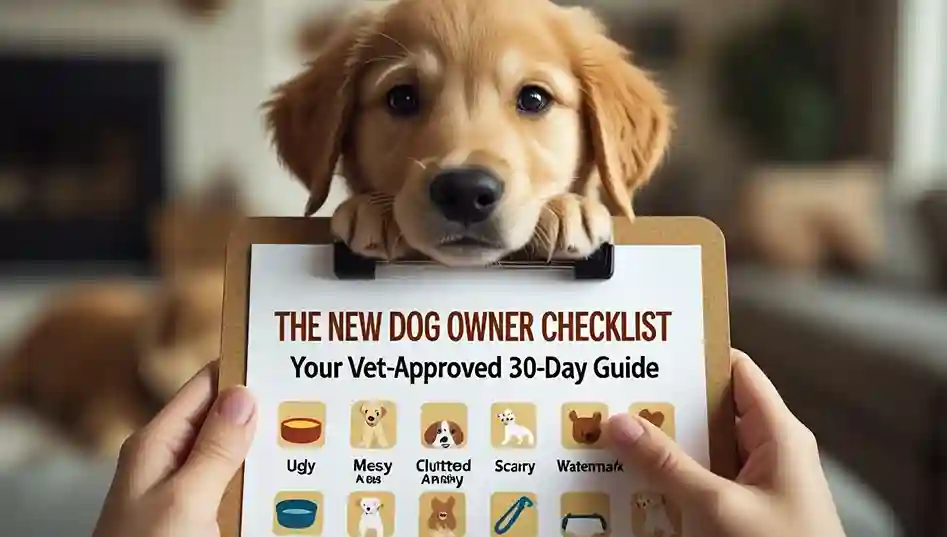If you’ve ever watched your dog suddenly transform into a whirling drive of pure, unbridled energy—racing in frantic circles around the living room or yard for no apparent reason—you’ve witnessed the famous “zoomies.” These sudden bursts of speed, officially known as Frenetic Random Activity Periods (FRAPs), are one of the most common and entertaining examples of canine behavior. While they might seem random, zoomies are a completely normal part of the behavioral spectrum covered in our guide to understanding dog behavior.
But what triggers this frantic display? Is it a sign of happiness, stress, or something else entirely? This vet-reviewed guide will demystify the phenomenon, explaining the common triggers—from post-bath freedom runs to post-poop victory laps—and, crucially, help you recognize when these energetic outbursts might signal an underlying issue that needs attention.
Let’s dive into the delightful and sometimes puzzling world of dog zoomies.
Key Takeaways: Dog Zoomies
Before we explore the specifics, here are the essential facts every dog owner should know about zoomies.
- 🌀 Zoomies Are Normal: These sudden energy bursts, called FRAPs (Frenetic Random Activity Periods), are a natural and common dog behavior.
- 🕒 Common Triggers: Zoomies often occur after specific events like baths, pooping, waking from naps, or during play when excitement peaks.
- 😊 Usually Positive: Most zoomies are a healthy release of pent-up energy or an expression of joy and don’t require intervention.
- ⚠️ Know When to Worry: Consult your veterinarian if zoomies are frequent, compulsive, cause injury, or are triggered by stress or fear.
- 🛡️ Safety First: Clear space for your dog to zoom safely, but avoid chasing or yelling, which can increase their excitement.
“At a Glance” Comparison Table: Normal vs. Concerning Zoomies
| Behavior | Normal Zoomies | Potential Concern |
|---|---|---|
| Frequency | Occasional (a few times per week) | Multiple times daily, seems compulsive or ritualistic. |
| Duration | Brief (30 seconds to 5 minutes) | Lasts 10+ minutes, dog seems unable to calm down. |
| Trigger | Positive events: after baths, pooping, play | Stressful events: after vet visits, during thunderstorms. |
| Body Language | Playful, loose, “happy” posture | Tense, frantic, stressed expression. |
| Recovery | Settles calmly on their own afterward | Remains panting, anxious, or hyperactive after zoomies. |
What Are Dog Zoomies? Understanding FRAPs
Zoomies might look like random chaos, but they’re actually a recognized canine behavior with both scientific explanation and practical meaning.
The Science Behind Frenetic Random Activity Periods
FRAPs are sudden, brief bursts of energy that serve as a natural pressure release valve for dogs. Scientifically, this behavior helps dogs discharge built-up stress or excess energy quickly and efficiently. It’s a leftover evolutionary trait from wild canines who needed sudden bursts of energy for hunting or escaping predators. The behavior triggers dopamine release in your dog’s brain, creating a natural high that explains why they seem so delighted during these episodes.
Zoomies Across Life Stages: Puppies vs. Adult Dogs vs. Seniors
Puppies experience frequent zoomies as they learn to manage their growing bodies and boundless energy. Adult dogs typically have zoomies triggered by specific events like baths or play sessions. Senior dogs may still get zoomies, but they’re often shorter in duration. Any significant increase in zoomies frequency in older dogs could indicate pain or cognitive changes and warrants veterinary attention.
Common Zoomies Triggers & What They Mean
Understanding what typically sets off these energetic outbursts can help you see them as communication rather than chaos.
Post-Bath Zoomies: The “Freedom Run”
This is one of the most common triggers. The zoomies after a bath are often a combination of relief (from the stressful bathing experience), the sensation of being “unbound” from the towel-drying, and the instinct to dry off and restore their natural scent. It’s essentially a celebratory release of tension.
Post-Poop Zoomies: The “Victory Lap”
Many dogs erupt into zoomies right after defecating. This can be a physical release of discomfort, a feeling of lightness, or even a primal instinct to move away from their waste to avoid attracting predators. It’s a very normal, self-rewarding behavior.
Morning & Evening Zoomies: Releasing Pent-Up Energy
These are classic energy-management zoomies. Morning zoomies often happen after a long night of rest, as a way to “shake off” sleep and rev up for the day. Evening zoomies are frequently a final effort to burn off any leftover energy from the day before settling down for the night.
Play-Induced Zoomies: Overflow of Excitement
During intense play sessions, excitement can reach a peak that spills over into a zoomies episode. This is a pure expression of joy and an inability to contain their happiness. It’s a sign your dog is having a fantastic time.
When to Be Concerned About Your Dog’s Zoomies
While most zoomies are harmless, there are specific situations where this behavior warrants closer attention and possibly veterinary consultation.
Signs Zoomies Might Indicate an Underlying Issue
Consult your veterinarian if zoomies are accompanied by:
- Frequent, compulsive episodes that occur multiple times daily.
- Signs of pain like yelping, limping, or sensitivity to touch.
- Environmental triggers like loud noises or specific fears.
- Inability to settle for extended periods after the episode.
- Self-injurious behavior such as crashing into walls or furniture.
Zoomies vs. Compulsive Behavior: Knowing the Difference
Normal zoomies are brief, context-appropriate, and the dog appears happy. Compulsive behavior is characterized by:
- Ritualistic patterns (always the same route or number of circles).
- Long duration (exceeding 10-15 minutes).
- Triggers that don’t make logical sense.
- Interference with normal activities like eating or sleeping.
- Continued performance even when exhausted.
Zoomies in Multi-Dog Households: Ensuring Safe Play
While zoomies can be contagious among dogs, monitor for:
- Appropriate play signals (play bows, loose body language).
- Balanced participation (dogs taking turns chasing).
- Breaks in the activity to prevent overstimulation.
- Safe space for any dog to opt out without being pursued.
- Intervention if play escalates to tension or aggression.
How to Manage Zoomies Safely
While you can’t—and shouldn’t always try to—stop the zoomies, you can manage them to keep your dog safe and even use that energy constructively.
Creating a Safe Zoomies Zone
The best approach is prevention. If you know your dog tends to zoom after a bath or first thing in the morning, pre-emptively clear the space.
- Move coffee tables and chairs to create a clear path.
- Use a high-quality, non-slip rug on slippery hardwood or tile floors to provide traction and prevent injury.
- If you have a yard, ensure the gate is closed and the area is secure. A sturdy, self-closing gate latch can provide peace of mind.
- For puppies or small breeds, a pet playpen can create a perfect, safe enclosure for zoomies to run their course.
Redirecting Energy: Using Zoomies for Training
Instead of trying to suppress the energy, channel it. Keep a stash of high-value treats or a favorite toy handy.
- When the zoomies start, try to redirect your dog into a structured activity. A long-lasting chew like a Kong filled with peanut butter can help them calm down.
- Toss a durable, fetch-specific toy in a safe direction to focus the energy outward.
- Never chase your dog during zoomies. Instead, call them to you and reward them heavily for complying. Using a training treat pouch makes this easy.
When to Intervene and When to Let It Be
Let it be if the zoomies are brief, your dog is in a safe space, and they seem genuinely happy. It’s a healthy release.
Intervene immediately if your dog is heading for danger, showing signs of stress, or the behavior is escalating.
A Veterinarian’s Perspective: Dr. Allona Jackson on Zoomies
“While zoomies are typically a normal and healthy behavior, I always advise owners to pay attention to the context and frequency. The vast majority of FRAPs are simply your dog’s way of releasing pent-up energy or expressing pure joy—think of it as their version of a happy dance. However, if your dog only gets zoomies during stressful events like thunderstorms or after nail trims, this could indicate anxiety rather than happiness.
I’m particularly concerned when zoomies become so intense that dogs injure themselves by crashing into furniture or walls, or when they can’t calm down afterward. In these cases, we should rule out underlying issues like pain, neurological conditions, or significant anxiety. For most dogs though, zoomies are a harmless and entertaining part of canine behavior—just make sure they have a safe space to express this natural energy release.”
— Dr. Allona Jackson, DVM, AvailPet’s Lead Veterinary Consultant
“How We Tested” Methodology
At AvailPet, we believe in providing accurate, evidence-based information about common canine behaviors. Our zoomies research followed a comprehensive approach to ensure both scientific validity and practical relevance for dog owners.
- Veterinary Behavior Analysis: This guide was developed in consultation with Dr. Allona Jackson, DVM to ensure accurate differentiation between normal zoomies and potential medical or behavioral concerns that might mimic FRAPs.
- Multi-Breed Observation: We documented zoomies episodes across various breed groups and ages, from high-energy herding breeds to more sedentary companion dogs, to identify patterns and variations in expression.
- Trigger Correlation Study: Our team analyzed hundreds of reported zoomies incidents to identify the most common triggers and contexts, providing reliable guidance for anticipating and understanding these energy bursts.
- Safety Protocol Development: We tested various management strategies in real-home environments to create effective safety recommendations for different living situations.
FAQs About Dog Zoomies
Are zoomies a sign of a happy dog?
Most of the time, yes! Zoomies are typically an expression of pure joy and a release of pent-up energy. You’ll usually see them when a dog is feeling playful and energetic—after a bath, during a fun play session, or when they’re particularly excited. However, always look at your dog’s overall body language. A happy zoomie dog will have a relaxed, wiggly body and a “smiling” expression.
Should I let my dog do zoomies?
Absolutely—as long as they’re in a safe environment. Zoomies are a natural and healthy way for dogs to burn off excess energy. Just make sure the area is clear of sharp objects, furniture they could crash into, and other hazards. If you’re indoors, you might want to guide them to a carpeted room to prevent slipping on hard floors.
Can I stop my dog from getting the zoomies?
While you can’t completely prevent this natural behavior, you can manage it. Regular exercise and mental stimulation through walks, play, and training can help reduce the frequency of zoomies by preventing energy buildup. If your dog tends to get zoomies at predictable times (like after dinner), you can proactively engage them in a calm activity instead.
Why does my dog get zoomies after pooping?
This is completely normal! Many dogs get what we call “post-poop zoomies.” It could be a combination of feeling physically relieved, a burst of energy from the physical exertion, or even an instinctual behavior to move away from their waste to avoid attracting predators. Think of it as their victory lap!
Conclusion
Understanding your dog’s zoomies transforms these chaotic bursts from puzzling behavior into a celebration of your dog’s natural energy and joy. By recognizing the common triggers and knowing how to ensure their safety, you can relax and enjoy this entertaining display of canine exuberance.
This guide to zoomies is just one part of understanding your dog’s unique language. To continue building your knowledge of canine behavior, from decoding body language to other common actions, explore our comprehensive guide to understanding dog behavior.
Sources:
- American Kennel Club (AKC). “Why Do Dogs Get the Zoomies?”
- Applied Animal Behaviour Science Journal. “Frenetic Random Activity Periods in Canines.”
- Review and input from Dr. Allona Jackson, DVM.
- International Association of Animal Behavior Consultants (IAABC). “Canine Enrichment.”
Full Disclosure: This article contains affiliate links. If you make a purchase through these links, we may earn a commission at no extra cost to you. This supports our research and allows us to continue providing valuable content.
Medical Disclaimer: This guide is for informational purposes only. Consult your veterinarian if you have concerns about your dog’s zoomies, especially if they’re frequent, intense, or accompanied by signs of stress or pain.






